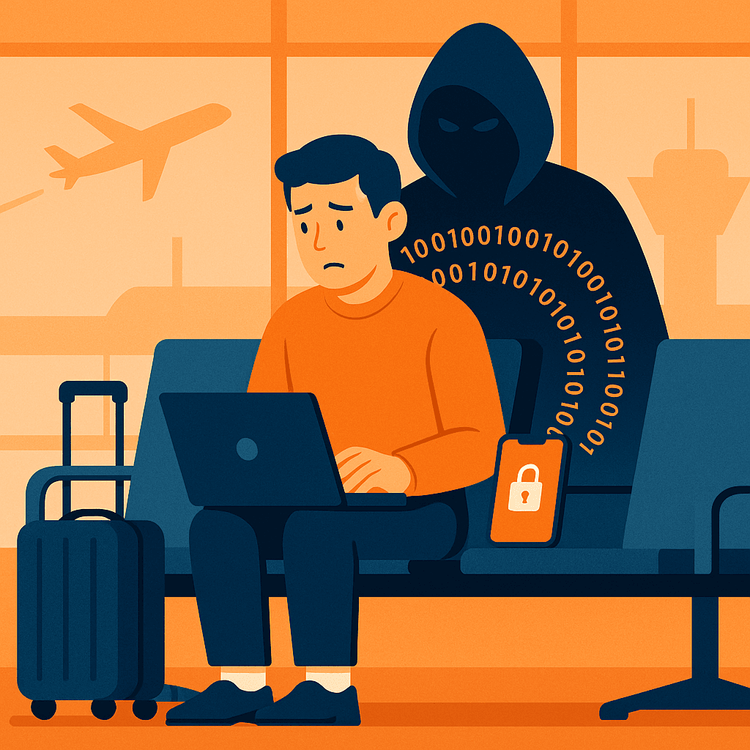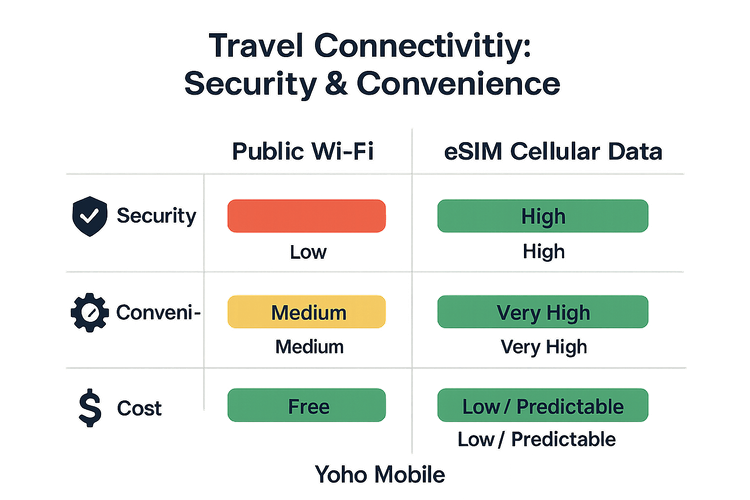Wi-Fi Público vs. Datos Móviles: Una Guía sobre la Seguridad de los Datos en Viajes
Bruce Li•Sep 21, 2025
En el momento en que aterrizas, el primer instinto suele ser conectarse. Esa red de “WiFi Gratis del Aeropuerto” parece un regalo, un puente de regreso a tu vida digital. Pero en el mundo de los viajes, lo que es gratis a menudo puede tener un costo muy alto: la seguridad de tus datos personales. Aunque convenientes, las redes Wi-Fi públicas en aeropuertos, hoteles y cafeterías son notoriamente inseguras.
Esta guía, basada en el consejo de expertos en ciberseguridad, desglosará las diferencias críticas entre usar Wi-Fi público y tus propios datos móviles personales. Exploraremos los riesgos reales del Wi-Fi público y te mostraremos por qué una conexión segura no es un lujo, sino una necesidad para el viajero moderno. ¿Listo para viajar de forma más inteligente? Empieza explorando planes de datos globales y seguros con Yoho Mobile.
Los Peligros Ocultos del Wi-Fi Público
Piensa en el Wi-Fi público como una plaza concurrida. Cualquiera puede estar allí, y no sabes quién está escuchando. Cuando te conectas, estás compartiendo la red con docenas, si no cientos, de extraños. Este entorno abierto es un patio de recreo para los ciberdelincuentes.
Estos son los principales riesgos del Wi-Fi público:
- Ataques de Intermediario (Man-in-the-Middle o MITM): Esta es la amenaza más común. Un hacker se posiciona entre tu dispositivo y el router Wi-Fi, interceptando todos los datos que envías y recibes. Esto puede incluir contraseñas, números de tarjetas de crédito y mensajes privados.
- Redes no Cifradas: Muchos puntos de acceso Wi-Fi gratuitos no cifran los datos que fluyen a través de ellos. Esto significa que tu información se envía en texto plano, haciéndola tan fácil de leer como una postal para cualquiera con las herramientas adecuadas.
- Distribución de Malware: Los hackers pueden usar redes Wi-Fi no seguras para inyectar malware en tu dispositivo. Hacer clic en una ventana emergente aparentemente inocente o conectarse a un punto de acceso malicioso (un “gemelo malvado” disfrazado del legítimo) puede comprometer todo tu sistema.
- Espionaje y “Sniffing”: Con software básico, un actor malicioso en la misma red puede ‘olfatear’ tu actividad, viendo qué sitios web visitas y qué datos transmites.
Según la Comisión Federal de Comercio de EE. UU. (FTC), es crucial ser precavido ya que no tienes control directo sobre la seguridad de una red pública.

Por Qué los Datos Móviles son tu Fortaleza Segura
A diferencia de la plaza pública que es el Wi-Fi, una conexión de datos móviles es un túnel privado y cifrado directamente entre tu dispositivo y la red de tu operador móvil. Esta diferencia fundamental en la arquitectura es lo que la hace inmensamente más segura.
Aquí tienes un desglose de las ventajas de seguridad de los datos móviles frente al Wi-Fi público:
- Cifrado Integrado: Las comunicaciones móviles, especialmente en redes 4G/LTE y 5G, están cifradas por defecto. Este cifrado es robusto y está estandarizado a nivel mundial, lo que hace extremadamente difícil que un hacker local intercepte y descifre tus datos.
- Autenticación: Tu dispositivo tiene una SIM o eSIM única que lo autentica con la red del operador. Esto crea una conexión de confianza, a diferencia del Wi-Fi público donde cualquier dispositivo puede unirse, a menudo sin ninguna verificación.
- Inmunidad a Amenazas Locales: Como no estás compartiendo una red local, estás protegido de los ataques MITM y el espionaje que plagan los puntos de acceso Wi-Fi públicos. Tu conexión evita por completo las vulnerabilidades del router local.
En esencia, usar tus propios datos es como tener un mensajero privado para tu información, mientras que el Wi-Fi público es como enviarla por correo ordinario sin sobre.
La Solución Moderna para Viajeros: eSIMs
La mejor manera de obtener datos móviles seguros y privados en el extranjero sin complicaciones es con una eSIM (SIM integrada). Una eSIM es una SIM digital que te permite activar un plan móvil sin necesidad de una tarjeta SIM física. Para los viajeros, es un cambio radical.
Puedes comprar e instalar un plan de datos directamente desde tu teléfono, obteniendo una conexión segura en el momento en que llegas a un nuevo país. ¿Planeando un viaje a EE. UU.? Puedes tener un plan de datos de alta velocidad listo incluso antes de abordar el avión. Explora los planes de eSIM flexibles de Yoho Mobile para los Estados Unidos.
Con Yoho Mobile, el proceso es increíblemente sencillo. Para los usuarios de iOS, no es necesario escanear un código QR o introducir códigos manualmente. Después de la compra, solo tienes que tocar ‘Instalar’ y tu iPhone te guiará a través de una configuración que toma menos de un minuto.
Antes de irte, siempre es una buena idea verificar si tu dispositivo es compatible con eSIM para asegurar una experiencia sin problemas.

Más Allá de la Seguridad: Las Ventajas Prácticas de Usar una eSIM
Aunque la seguridad de los datos en el extranjero es el principal beneficio, usar una eSIM de Yoho Mobile ofrece otras fantásticas ventajas para los viajeros:
- Económico: Evita las exorbitantes tarifas de roaming internacional de tu operador local. Yoho Mobile ofrece paquetes de datos transparentes y asequibles, adaptados a tu destino y necesidades.
- Conectividad Ininterrumpida: Deja de perder valioso tiempo de vacaciones buscando cafeterías con buen Wi-Fi. Tienes internet fiable dondequiera que haya señal móvil.
- Tranquilidad Total con Yoho Care: ¿Alguna vez te ha preocupado quedarte sin datos en un momento crítico? Con Yoho Care, nunca estás completamente desconectado. Incluso si tu paquete de datos principal se agota, te proporcionamos una conexión de respaldo para asegurar que aún puedas usar mapas o enviar un mensaje de emergencia.
- Prueba Antes de Comprometerte: ¿Eres nuevo en las eSIMs? Experimenta la libertad por ti mismo. Prueba nuestro servicio completamente sin riesgo con una prueba gratuita de eSIM y comprueba lo fácil que es mantenerse conectado de forma segura.
Preguntas Frecuentes (FAQ)
P1: ¿Es seguro el Wi-Fi del hotel para la banca online?
Se desaconseja firmemente realizar transacciones sensibles como la banca online en el Wi-Fi de un hotel o en cualquier red pública. Estas redes son objetivos principales para los hackers. Usa siempre tus datos móviles seguros para cualquier actividad que involucre contraseñas, información financiera o datos personales para asegurar que permanezcan cifrados y privados.
P2: ¿Puedo usar una VPN en un Wi-Fi público para mayor seguridad?
Sí, usar una VPN (Red Privada Virtual) de confianza es una excelente manera de añadir una capa de cifrado robusta a tu conexión en Wi-Fi público. Crea un túnel seguro para tus datos, haciendo mucho más difícil que alguien los intercepte. Sin embargo, una conexión móvil segura a través de eSIM es inherentemente más segura y no requiere una suscripción adicional ni la posible reducción de velocidad de una VPN.
P3: ¿Es una eSIM más segura que comprar una tarjeta SIM física local?
Desde el punto de vista de la transmisión de datos, tanto una eSIM como una SIM física proporcionan el mismo alto nivel de seguridad de la red móvil. La principal ventaja de seguridad y conveniencia de una eSIM está en el proceso de adquisición. Evitas posibles estafas en tiendas locales de tarjetas SIM y no necesitas entregar tu pasaporte o información personal a vendedores desconocidos. Puedes comprarla y activarla de forma segura online.
P4: ¿Cómo puedo proteger mis datos si es absolutamente necesario que use Wi-Fi público?
Si usar datos móviles no es una opción, sigue estos pasos: usa una VPN, asegúrate de que el nombre de la red sea correcto (evita los ‘gemelos malvados’), utiliza solo sitios web con cifrado HTTPS (busca el icono del candado en tu navegador), desactiva el uso compartido de archivos y ‘olvida’ la red cuando termines. Para más consejos, puedes leer recomendaciones de expertos en seguridad como la Electronic Frontier Foundation (EFF).
Conclusión: Tus Datos Merecen un Billete de Primera Clase
Aunque la tentación del Wi-Fi gratuito es fuerte, el costo potencial para tu seguridad digital es mucho mayor. La evidencia es clara: para los viajeros en 2025, los datos móviles personales ofrecen una conexión inmensamente superior, cifrada y fiable.
Al elegir una eSIM de Yoho Mobile, no solo estás comprando datos; estás invirtiendo en tranquilidad. Obtienes la libertad de explorar, compartir y navegar sin preocuparte constantemente por quién podría estar vigilando tu conexión. No dejes vulnerable tu activo más valioso: tus datos personales.
Explora hoy los planes eSIM globales de Yoho Mobile y viaja con la confianza de una conexión segura.

